Maximilian Schiffer
Reproducibility in the Control of Autonomous Mobility-on-Demand Systems
Jun 09, 2025Abstract:Autonomous Mobility-on-Demand (AMoD) systems, powered by advances in robotics, control, and Machine Learning (ML), offer a promising paradigm for future urban transportation. AMoD offers fast and personalized travel services by leveraging centralized control of autonomous vehicle fleets to optimize operations and enhance service performance. However, the rapid growth of this field has outpaced the development of standardized practices for evaluating and reporting results, leading to significant challenges in reproducibility. As AMoD control algorithms become increasingly complex and data-driven, a lack of transparency in modeling assumptions, experimental setups, and algorithmic implementation hinders scientific progress and undermines confidence in the results. This paper presents a systematic study of reproducibility in AMoD research. We identify key components across the research pipeline, spanning system modeling, control problems, simulation design, algorithm specification, and evaluation, and analyze common sources of irreproducibility. We survey prevalent practices in the literature, highlight gaps, and propose a structured framework to assess and improve reproducibility. Specifically, concrete guidelines are offered, along with a "reproducibility checklist", to support future work in achieving replicable, comparable, and extensible results. While focused on AMoD, the principles and practices we advocate generalize to a broader class of cyber-physical systems that rely on networked autonomy and data-driven control. This work aims to lay the foundation for a more transparent and reproducible research culture in the design and deployment of intelligent mobility systems.
Optimization-Augmented Machine Learning for Vehicle Operations in Emergency Medical Services
Mar 14, 2025Abstract:Minimizing response times to meet legal requirements and serve patients in a timely manner is crucial for Emergency Medical Service (EMS) systems. Achieving this goal necessitates optimizing operational decision-making to efficiently manage ambulances. Against this background, we study a centrally controlled EMS system for which we learn an online ambulance dispatching and redeployment policy that aims at minimizing the mean response time of ambulances within the system by dispatching an ambulance upon receiving an emergency call and redeploying it to a waiting location upon the completion of its service. We propose a novel combinatorial optimization-augmented machine learning pipeline that allows to learn efficient policies for ambulance dispatching and redeployment. In this context, we further show how to solve the underlying full-information problem to generate training data and propose an augmentation scheme that improves our pipeline's generalization performance by mitigating a possible distribution mismatch with respect to the considered state space. Compared to existing methods that rely on augmentation during training, our approach offers substantial runtime savings of up to 87.9% while yielding competitive performance. To evaluate the performance of our pipeline against current industry practices, we conduct a numerical case study on the example of San Francisco's 911 call data. Results show that the learned policies outperform the online benchmarks across various resource and demand scenarios, yielding a reduction in mean response time of up to 30%.
Preference-aware compensation policies for crowdsourced on-demand services
Feb 07, 2025Abstract:Crowdsourced on-demand services offer benefits such as reduced costs, faster service fulfillment times, greater adaptability, and contributions to sustainable urban transportation in on-demand delivery contexts. However, the success of an on-demand platform that utilizes crowdsourcing relies on finding a compensation policy that strikes a balance between creating attractive offers for gig workers and ensuring profitability. In this work, we examine a dynamic pricing problem for an on-demand platform that sets request-specific compensation of gig workers in a discrete-time framework, where requests and workers arrive stochastically. The operator's goal is to determine a compensation policy that maximizes the total expected reward over the time horizon. Our approach introduces compensation strategies that explicitly account for gig worker request preferences. To achieve this, we employ the Multinomial Logit model to represent the acceptance probabilities of gig workers, and, as a result, derive an analytical solution that utilizes post-decision states. Subsequently, we integrate this solution into an approximate dynamic programming algorithm. We compare our algorithm against benchmark algorithms, including formula-based policies and an upper bound provided by the full information linear programming solution. Our algorithm demonstrates consistent performance across diverse settings, achieving improvements of at least 2.5-7.5% in homogeneous gig worker populations and 9% in heterogeneous populations over benchmarks, based on fully synthetic data. For real-world data, it surpasses benchmarks by 8% in weak and 20% in strong location preference scenarios.
WardropNet: Traffic Flow Predictions via Equilibrium-Augmented Learning
Oct 09, 2024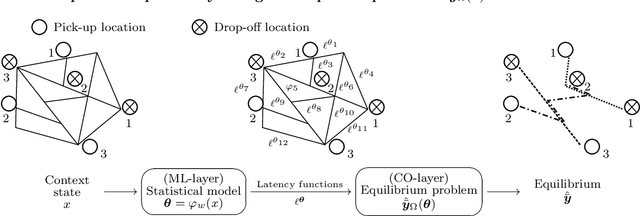

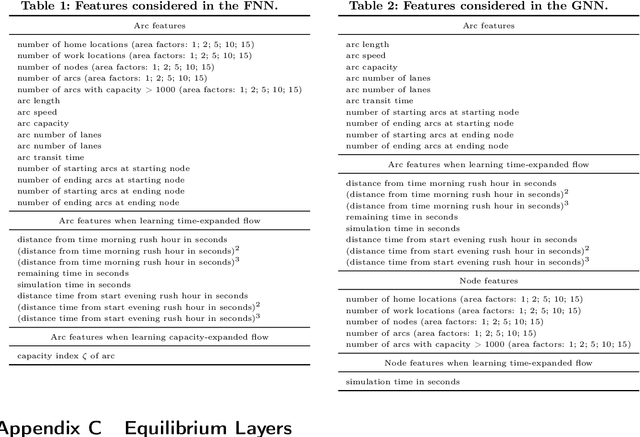
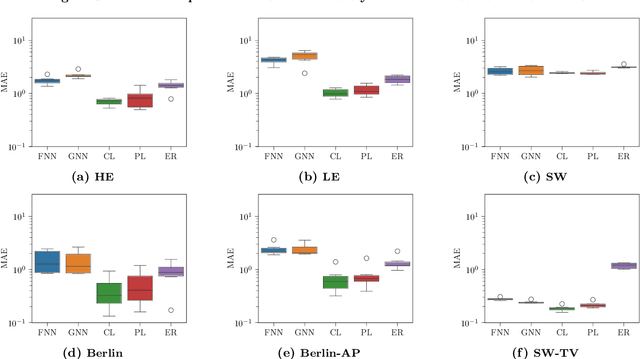
Abstract:When optimizing transportation systems, anticipating traffic flows is a central element. Yet, computing such traffic equilibria remains computationally expensive. Against this background, we introduce a novel combinatorial optimization augmented neural network architecture that allows for fast and accurate traffic flow predictions. We propose WardropNet, a neural network that combines classical layers with a subsequent equilibrium layer: the first ones inform the latter by predicting the parameterization of the equilibrium problem's latency functions. Using supervised learning we minimize the difference between the actual traffic flow and the predicted output. We show how to leverage a Bregman divergence fitting the geometry of the equilibria, which allows for end-to-end learning. WardropNet outperforms pure learning-based approaches in predicting traffic equilibria for realistic and stylized traffic scenarios. On realistic scenarios, WardropNet improves on average for time-invariant predictions by up to 72% and for time-variant predictions by up to 23% over pure learning-based approaches.
Multi-Agent Soft Actor-Critic with Global Loss for Autonomous Mobility-on-Demand Fleet Control
Apr 10, 2024Abstract:We study a sequential decision-making problem for a profit-maximizing operator of an Autonomous Mobility-on-Demand system. Optimizing a central operator's vehicle-to-request dispatching policy requires efficient and effective fleet control strategies. To this end, we employ a multi-agent Soft Actor-Critic algorithm combined with weighted bipartite matching. We propose a novel vehicle-based algorithm architecture and adapt the critic's loss function to appropriately consider global actions. Furthermore, we extend our algorithm to incorporate rebalancing capabilities. Through numerical experiments, we show that our approach outperforms state-of-the-art benchmarks by up to 12.9% for dispatching and up to 38.9% with integrated rebalancing.
Risk-Sensitive Soft Actor-Critic for Robust Deep Reinforcement Learning under Distribution Shifts
Feb 15, 2024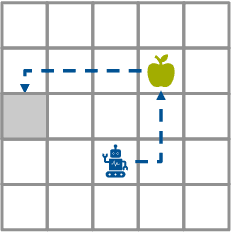

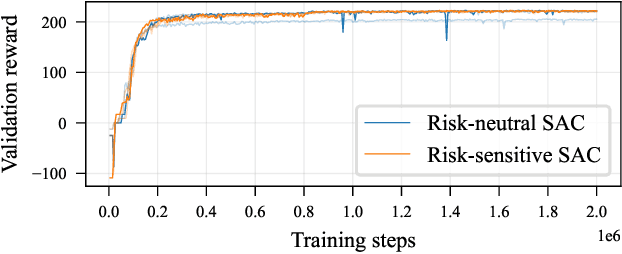
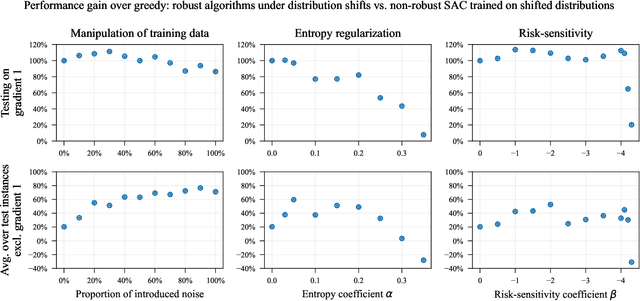
Abstract:We study the robustness of deep reinforcement learning algorithms against distribution shifts within contextual multi-stage stochastic combinatorial optimization problems from the operations research domain. In this context, risk-sensitive algorithms promise to learn robust policies. While this field is of general interest to the reinforcement learning community, most studies up-to-date focus on theoretical results rather than real-world performance. With this work, we aim to bridge this gap by formally deriving a novel risk-sensitive deep reinforcement learning algorithm while providing numerical evidence for its efficacy. Specifically, we introduce discrete Soft Actor-Critic for the entropic risk measure by deriving a version of the Bellman equation for the respective Q-values. We establish a corresponding policy improvement result and infer a practical algorithm. We introduce an environment that represents typical contextual multi-stage stochastic combinatorial optimization problems and perform numerical experiments to empirically validate our algorithm's robustness against realistic distribution shifts, without compromising performance on the training distribution. We show that our algorithm is superior to risk-neutral Soft Actor-Critic as well as to two benchmark approaches for robust deep reinforcement learning. Thereby, we provide the first structured analysis on the robustness of reinforcement learning under distribution shifts in the realm of contextual multi-stage stochastic combinatorial optimization problems.
Contextual Stochastic Vehicle Routing with Time Windows
Feb 10, 2024

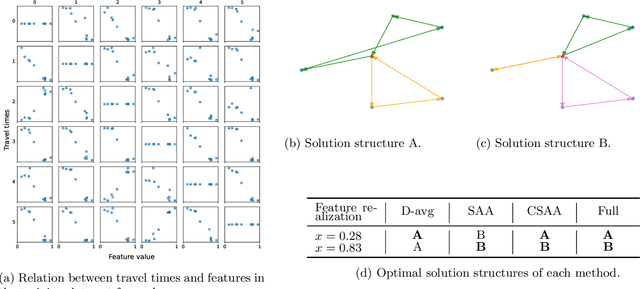
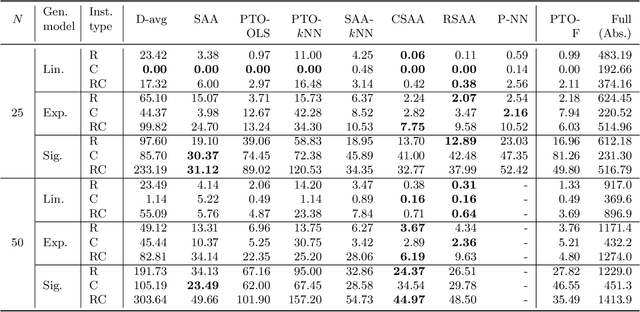
Abstract:We study the vehicle routing problem with time windows (VRPTW) and stochastic travel times, in which the decision-maker observes related contextual information, represented as feature variables, before making routing decisions. Despite the extensive literature on stochastic VRPs, the integration of feature variables has received limited attention in this context. We introduce the contextual stochastic VRPTW, which minimizes the total transportation cost and expected late arrival penalties conditioned on the observed features. Since the joint distribution of travel times and features is unknown, we present novel data-driven prescriptive models that use historical data to provide an approximate solution to the problem. We distinguish the prescriptive models between point-based approximation, sample average approximation, and penalty-based approximation, each taking a different perspective on dealing with stochastic travel times and features. We develop specialized branch-price-and-cut algorithms to solve these data-driven prescriptive models. In our computational experiments, we compare the out-of-sample cost performance of different methods on instances with up to one hundred customers. Our results show that, surprisingly, a feature-dependent sample average approximation outperforms existing and novel methods in most settings.
Global Rewards in Multi-Agent Deep Reinforcement Learning for Autonomous Mobility on Demand Systems
Dec 14, 2023Abstract:We study vehicle dispatching in autonomous mobility on demand (AMoD) systems, where a central operator assigns vehicles to customer requests or rejects these with the aim of maximizing its total profit. Recent approaches use multi-agent deep reinforcement learning (MADRL) to realize scalable yet performant algorithms, but train agents based on local rewards, which distorts the reward signal with respect to the system-wide profit, leading to lower performance. We therefore propose a novel global-rewards-based MADRL algorithm for vehicle dispatching in AMoD systems, which resolves so far existing goal conflicts between the trained agents and the operator by assigning rewards to agents leveraging a counterfactual baseline. Our algorithm shows statistically significant improvements across various settings on real-world data compared to state-of-the-art MADRL algorithms with local rewards. We further provide a structural analysis which shows that the utilization of global rewards can improve implicit vehicle balancing and demand forecasting abilities. Our code is available at https://github.com/tumBAIS/GR-MADRL-AMoD.
Ambulance Demand Prediction via Convolutional Neural Networks
Jun 08, 2023Abstract:Minimizing response times is crucial for emergency medical services to reduce patients' waiting times and to increase their survival rates. Many models exist to optimize operational tasks such as ambulance allocation and dispatching. Including accurate demand forecasts in such models can improve operational decision-making. Against this background, we present a novel convolutional neural network (CNN) architecture that transforms time series data into heatmaps to predict ambulance demand. Applying such predictions requires incorporating external features that influence ambulance demands. We contribute to the existing literature by providing a flexible, generic CNN architecture, allowing for the inclusion of external features with varying dimensions. Additionally, we provide a feature selection and hyperparameter optimization framework utilizing Bayesian optimization. We integrate historical ambulance demand and external information such as weather, events, holidays, and time. To show the superiority of the developed CNN architecture over existing approaches, we conduct a case study for Seattle's 911 call data and include external information. We show that the developed CNN architecture outperforms existing state-of-the-art methods and industry practice by more than 9%.
Handling Large Discrete Action Spaces via Dynamic Neighborhood Construction
May 31, 2023Abstract:Large discrete action spaces remain a central challenge for reinforcement learning methods. Such spaces are encountered in many real-world applications, e.g., recommender systems, multi-step planning, and inventory replenishment. The mapping of continuous proxies to discrete actions is a promising paradigm for handling large discrete action spaces. Existing continuous-to-discrete mapping approaches involve searching for discrete neighboring actions in a static pre-defined neighborhood, which requires discrete neighbor lookups across the entire action space. Hence, scalability issues persist. To mitigate this drawback, we propose a novel Dynamic Neighborhood Construction (DNC) method, which dynamically constructs a discrete neighborhood to map the continuous proxy, thus efficiently exploiting the underlying action space. We demonstrate the robustness of our method by benchmarking it against three state-of-the-art approaches designed for large discrete action spaces across three different environments. Our results show that DNC matches or outperforms state-of-the-art approaches while being more computationally efficient. Furthermore, our method scales to action spaces that so far remained computationally intractable for existing methodologies.
 Add to Chrome
Add to Chrome Add to Firefox
Add to Firefox Add to Edge
Add to Edge